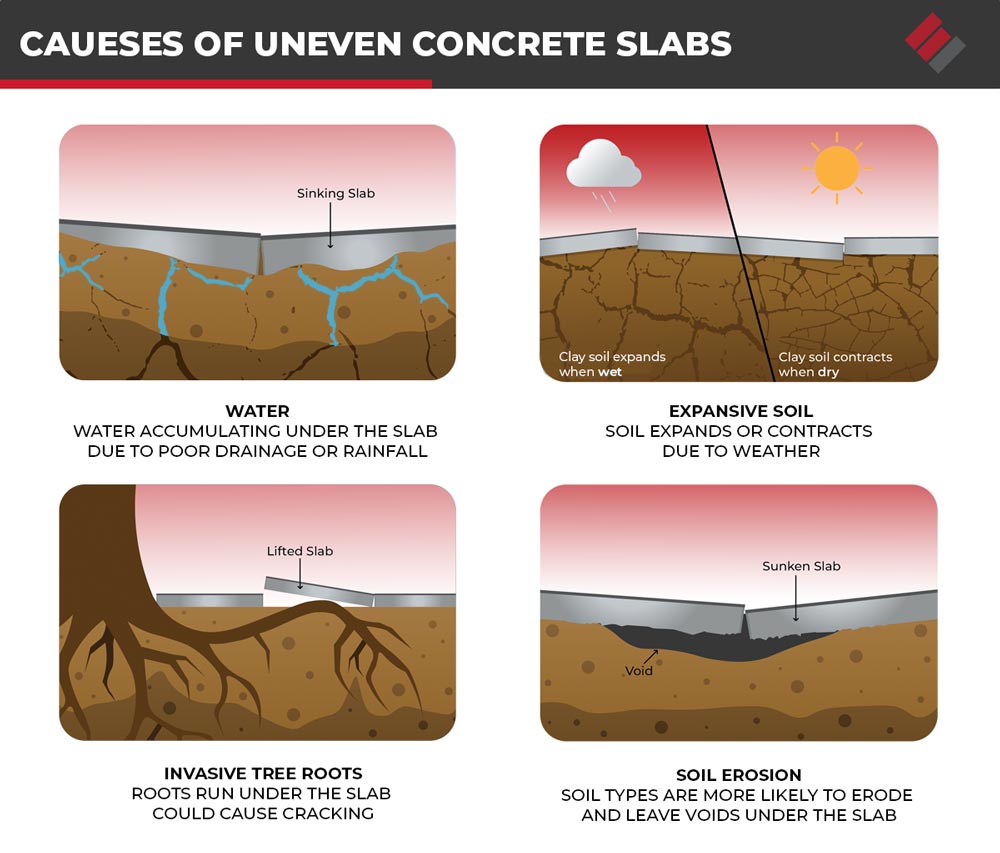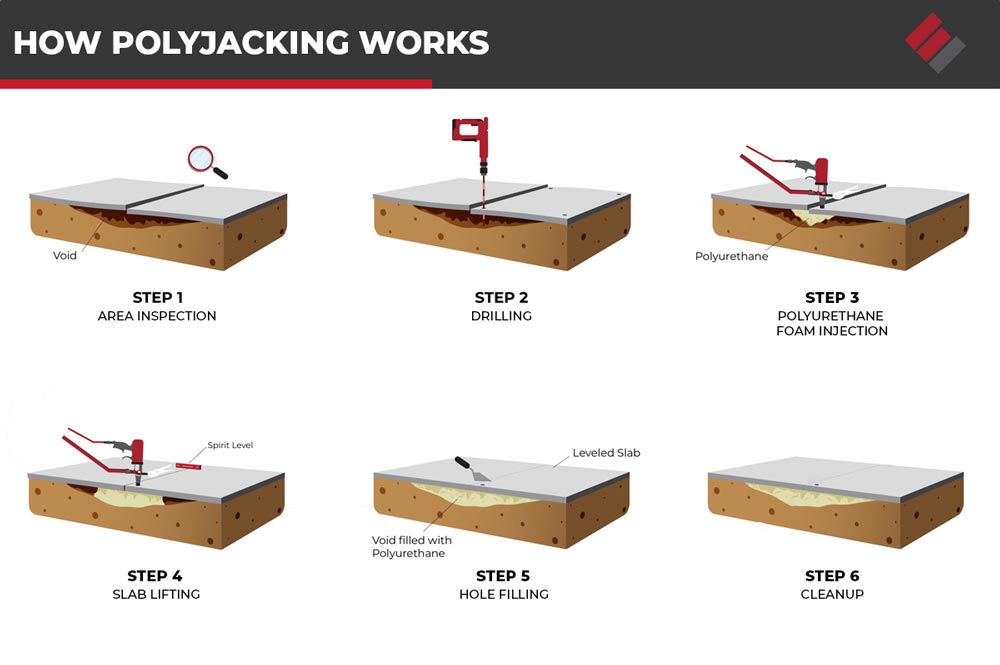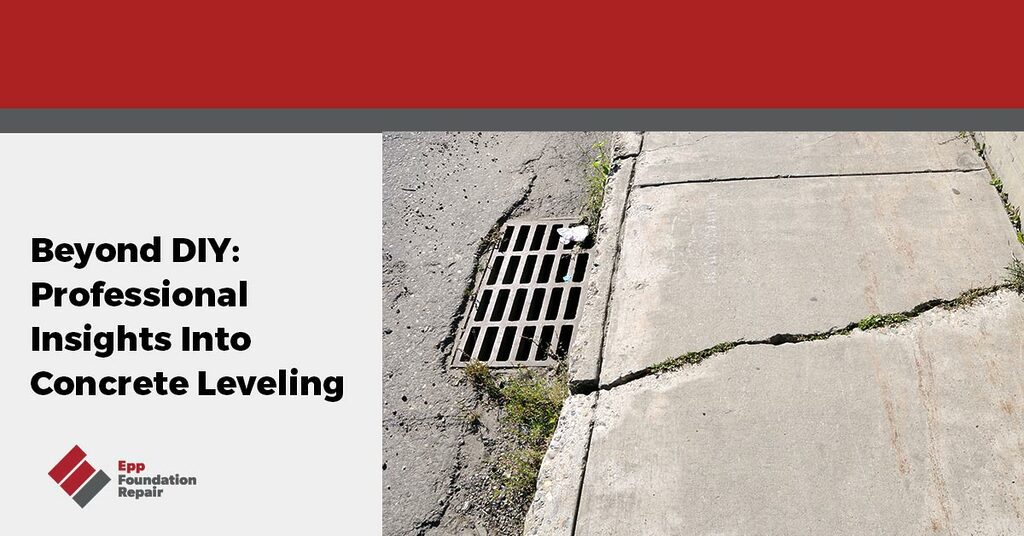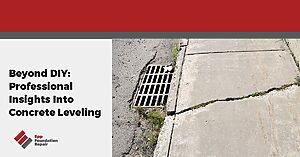Homeowners may face many issues on their property, some of which are easy to care for and others more complex. A homeowner may even feel capable of doing most tasks around the home, but should they tackle the job of concrete leveling?
On the surface, a project of concrete leveling may look somewhat easy. When you get into the project, however, you quickly realize there is much more to it, and using a professional has definite advantages.
First of all, most homeowners don’t own the tools necessary to do the job of concrete leveling as a DIY project. Some of the tools required may include a hydraulic pump and a heavy-duty concrete drill.
Renting these tools may cost more and be more of a hassle than it is worth in comparison to hiring a professional to do the job.
In addition, professional contractors have the experience necessary to determine what is behind the sinking, unlevel concrete. Rather than simply leveling the concrete, they can correct any problems that would cause it to continue to sink in the future.
In this article, we will take a look into some of the issues associated with unlevel concrete. We will also dig deeper to find out why concrete may be unlevel in the first place and why, in some cases, it may not be worth repairing.
What Is the Problem with Sinking and Unlevel Concrete?
Sinking concrete is more than an eyesore. There are additional problems to be considered, as these are the real reasons why you should have sinking and unlevel concrete repaired as soon as possible.
Safety: When concrete sinks, it does not always sink at the same rate. You may end up with uneven surfaces due to cracks or at the edge of the slab. It is more likely to trip or fall due to sinking concrete when you reach those elevation changes.
We live in a world of distraction. Most people are not constantly watching their step when they are walking. Your and your family’s safety could be compromised due to sinking concrete.
Liabilities: Beyond the possibility of tripping and falling, you also need to be concerned about legal liabilities if injuries occur due to negligence. If somebody trips and falls on your property, whether it is your personal or commercial property, you could be held liable for any damages.
Accessibility: Individuals with mobility difficulties often rely on concrete surfaces to get from one point to another. A lack of accessibility puts them at a disadvantage. It is not only an unkind act; legal concerns could exist if accessibility is limited due to sinking concrete.
What Causes Unlevel Concrete?
It is one thing to have unlevel concrete repaired. It is quite another to understand what is causing the problem so it could be corrected.
The root cause of sinking concrete is not always evident by what you see on the surface. In addition, multiple problems may occur simultaneously, and if they aren’t all corrected, it could lead to the same problem continuing to occur.
The following are some of the more common reasons why a concrete slab would sink.

Water: The action of water can be damaging to the soil under the slab. Excessive water, likely due to poor drainage or heavy rainfall, could easily lead to this problem.
Poor Soil Conditions: In many areas, expansive soil can wreak havoc on concrete slabs, foundations, and any other construction taking place on the property. Expansive soil expands when wet, which could cause the concrete to rise.
As the soil dries, however, it shrinks and leaves voids under the concrete slab. Since the slab is no longer supported in those areas, it may sink unevenly and will likely crack.
Tree Roots: Nearby tree roots can be a problem for concrete slabs. If the roots run under the slab, it could cause cracking or displace the soil, leading to sinking.
Even if the tree roots are not directly under the concrete slab, they could pull much of the moisture from the soil, resulting in voids under the slab.
Soil Erosion: Certain soil types are more likely to erode and leave voids under the slab. However, almost any kind of soil can be easily eroded if the surface water is not draining properly from the area.
Is Your Slab Beyond Repair?
Most concrete slabs can be repaired and leveled using polyjacking. However, there are some cases when the damage is more severe, and removing and replacing the old slab may be necessary.
Even somebody trying to DIY the concrete repair will not be able to fix the concrete if it is damaged beyond repair. Here are a few different conditions that may make that possible.
Cracked Concrete: Some cracks will not stop the concrete leveling process. The gap may even close considerably as the concrete is leveled.
If the cracks are extensive or spiderwebbed, there may not be enough of the slab left to support a lift. In this case, the slab will have to be removed and replaced.
Uneven Surfaces: This problem sometimes occurs due to an improper pour. If the surface has dips or is uneven due to that reason, then slabjacking will not fix the problem.
Other issues beyond the obvious could keep a slab from being lifted. It is another reason why DIY concrete leveling is not the right choice. A professional can assess the situation and know the right decision to make.
Concrete Leveling Through Polyjacking
Hiring a contractor to level the concrete rather than taking it on as a DIY project also provides another benefit. A contractor can use a special technique known as polyjacking to lift the concrete into position quickly and easily using special tools and materials.
Polyjacking is a process that uses polyurethane foam that is injected under the slab into the voids. As the foam expands, it compacts the soil under the slab while simultaneously lifting the slab into place.

Small holes, approximately the size of a dime, will be drilled through the concrete to accomplish this task. Special ports are inserted into those holes to attach an injection gun.
A two-part polyurethane mixture is then injected under the concrete through those holes, and as it mixes, it expands rapidly. The professional injecting the polyurethane will monitor the process carefully so the slab is lifted into position with precision.
Once the slab has been lifted, the ports are removed, and the concrete is patched. Care is taken to match the color of the concrete as closely as possible.
The best news is that you can start using the slab again within about 15 minutes after the job is complete. Polyjacking is a permanent solution that will not negatively impact the environment.
If you are ready to have a slab leveling job done, you can call the pros at EPP Foundation Repair. We can assess the situation and let you know how we can get your slab back into shape again.







